Part 1: Six Split Pea Soups from Around the World
There are as many recipes for yellow and green split pea soups as there are cooks in the world. With their wonderful taste and versatility, split peas can be combined with a wide range of ingredients—from coconut milk to bacon and ham, and from tomatoes to olive oil and lard—to create delicious dishes. Typically, the ingredients used are influenced by what’s available, making each recipe unique and adaptable.
Before we dive into the visual recipe of a Greek/Mediterranean Yellow Split Pea Soup, where high-phenolic olive oil truly shines and creates a synergy between the two main ingredients—resulting in a powerhouse of nutrition and taste—it’s fun to explore a few other famous split pea soup recipes from around the world.
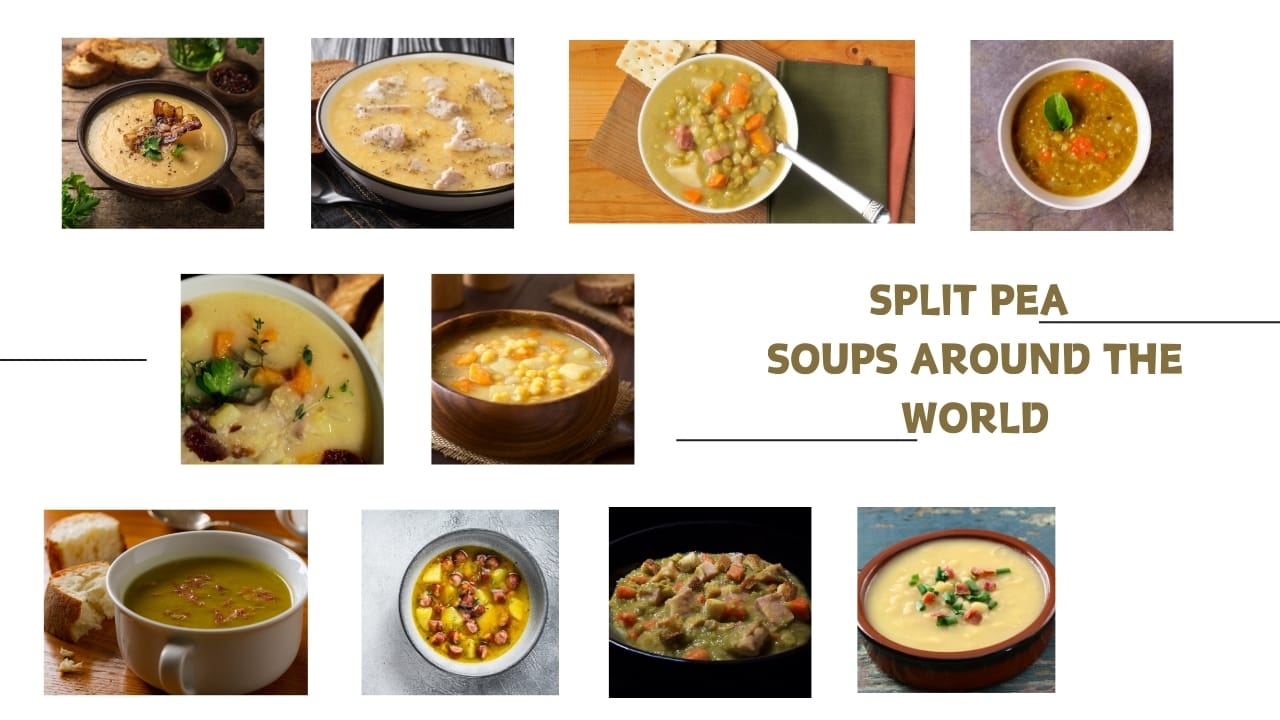
1) Sweden: Ärtsoppa—Swedish Yellow Split Pea Soup
One such recipe, which my friend told me about and which her Swedish grandmother used to make, is Ärtsoppa. Ärtsoppa, a traditional Swedish yellow split pea soup, is made with ham or pork and aromatic herbs like bay leaves and thyme. Its history dates back to the Middle Ages when it was a staple dish, commonly enjoyed on Thursdays. Traditionally, Thursdays were market days, making it practical to prepare a hearty, nutritious meal like Ärtsoppa to last through the fasting on Friday. The soup was filling, economical, and provided warmth and sustenance, especially during the colder months. Over time, even as the original reason for "Thursday's Special" faded, the tradition became so ingrained in Swedish culture that many in Sweden still enjoy this classic, comforting soup on Thursdays.
Typical ingredients in Ärtsoppa: Dried yellow split peas, ham or pork, onions, bay leaves, thyme, and mustard for serving.
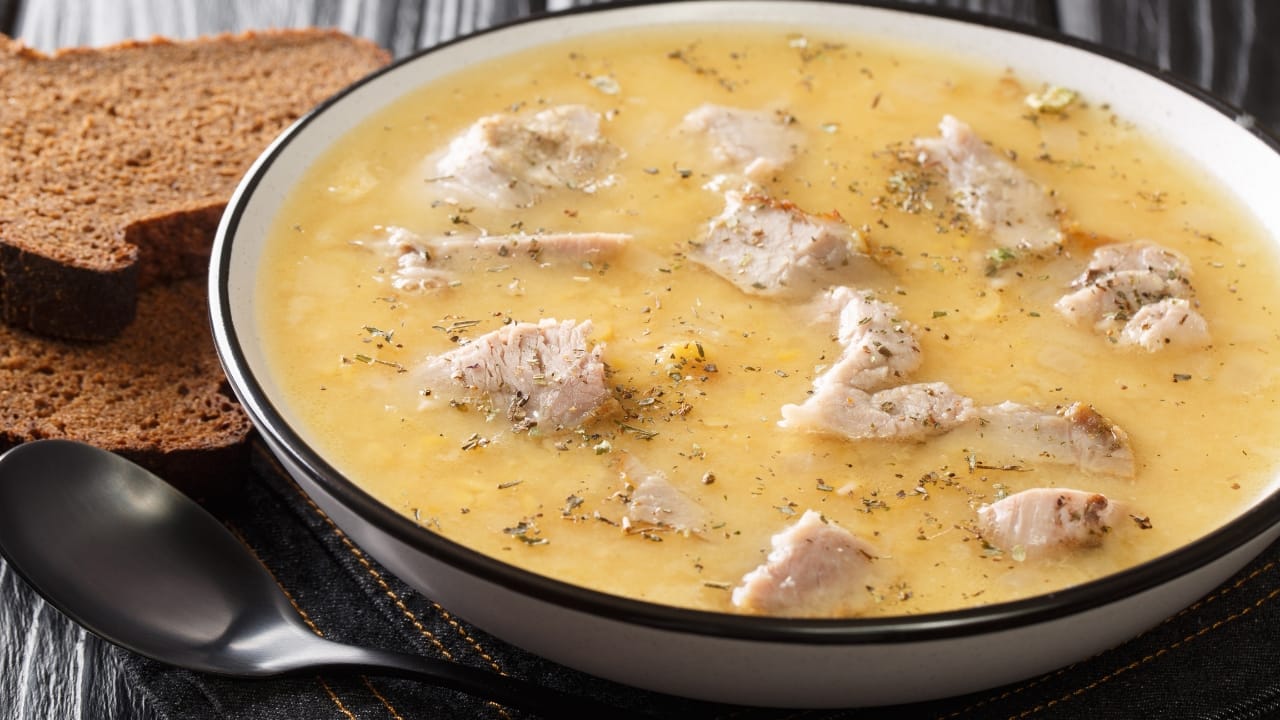
2) United Kingdom: “Pease Pudding”
I remember being so surprised when I first learned that the "pease pudding" from the 18th-century nursery rhyme "Pease Pudding Hot" was actually what we might call today a thick soup or porridge made of yellow split peas.
The rhyme we all learned as children goes like this:
Pease pudding hot, pease pudding cold,
Pease pudding in the pot, nine days old.
Some like it hot, some like it cold,
Some like it in the pot, nine days old.
As a child, I used to wonder, "Why would anyone eat peas that were nine days old?!" Now, I realize that the "nine days old" part of the rhyme was likely an exaggeration for effect. It might have been a tasty dish, but who would really want to eat it for nine consecutive days, or nine days after it was made? Unless, of course, it was so cold that it had frozen solid, in which case it would still be good! After all, it was—and still is—both economical and nutritious.
What's interesting is that this dish was so central to life in England at the time that a nursery rhyme was created to immortalize it. It became a catchy little ditty, making children excited, or at least curious, about eating it.
Today, we'd probably consider Pease Pudding closer to a thick pea soup than a porridge. And just as a fun note: in Middle English, "pease" was originally a singular noun for what we now call "peas." Now "pea" (not "pease") is, of course, the singular, and "peas" is the plural.
Typical ingredients in Pease Porridge: Dried yellow split peas, water or broth, salt, and pepper. Optional additions include bacon, ham, or salted pork, as well as onions, thyme, or bay leaves for extra flavor.
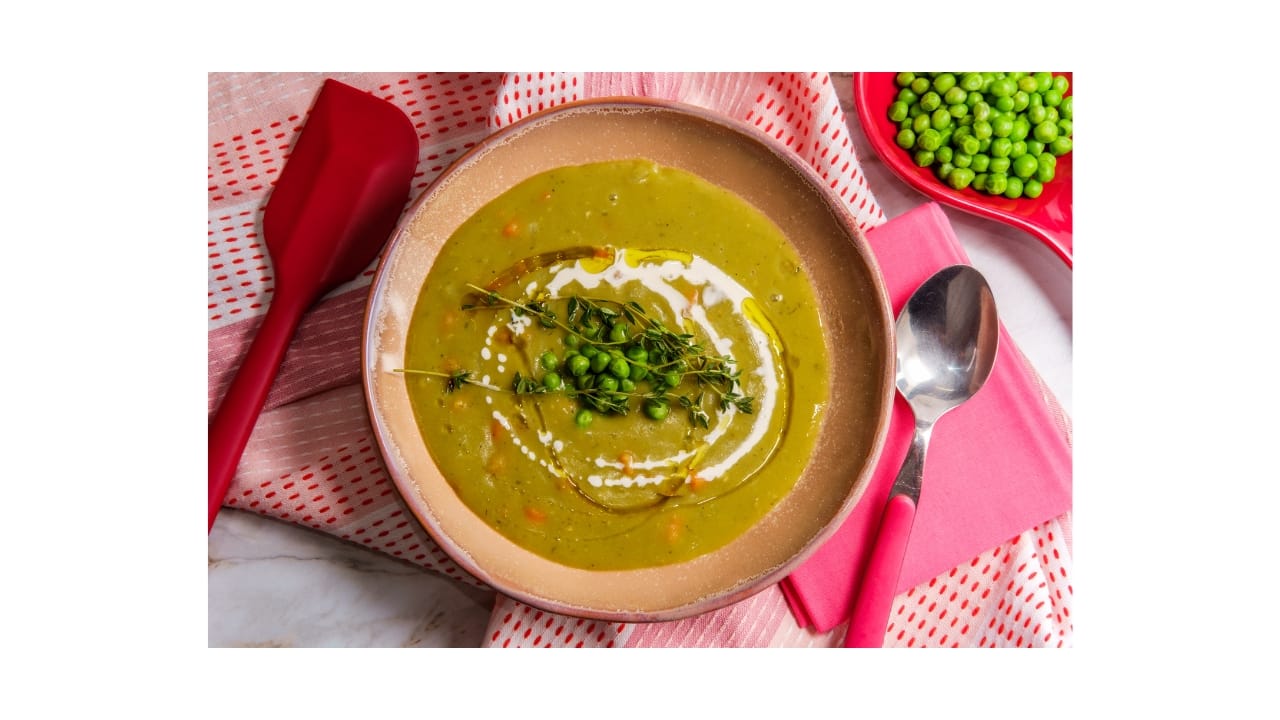
3) India: Yellow or Toor Dal
When made with lentils, this famous Indian dish is simply called "Dal" or "Daal," which is a more general term encompassing a variety of dishes made from pulses, including both split peas and lentils. The specific name of the Dal can vary depending on the type of pulse used and the region of India. For instance, "Toor Dal" specifically refers to dishes made with yellow split peas (or sometime pigeon peas — cajan), while Masoor Dal refers to dishes made with red lentils, and Chana Dal is made with split chickpeas (see here for the difference between these and split peas).
In its preparation, Yellow Dal (Toor Dal) can range from a thick stew to a more soupy consistency, depending on personal preference. This dish is a staple in Indian cuisine, commonly enjoyed with rice or flatbreads like chapati or naan. Celebrated for its nutritional benefits, Yellow Dal provides a rich source of protein, fiber, and essential vitamins. Its versatility makes it a frequent choice for daily meals, yet it can also be elevated for special occasions with added spices or ingredients.
Typical ingredients in Yellow or Toor Dal: Dried yellow split peas (or else pigeon peas), turmeric, cumin, coriander, garlic, ginger, onions, tomatoes (optional), green chilies, ghee or oil, mustard seeds (optional), and fresh cilantro for garnish (optional).
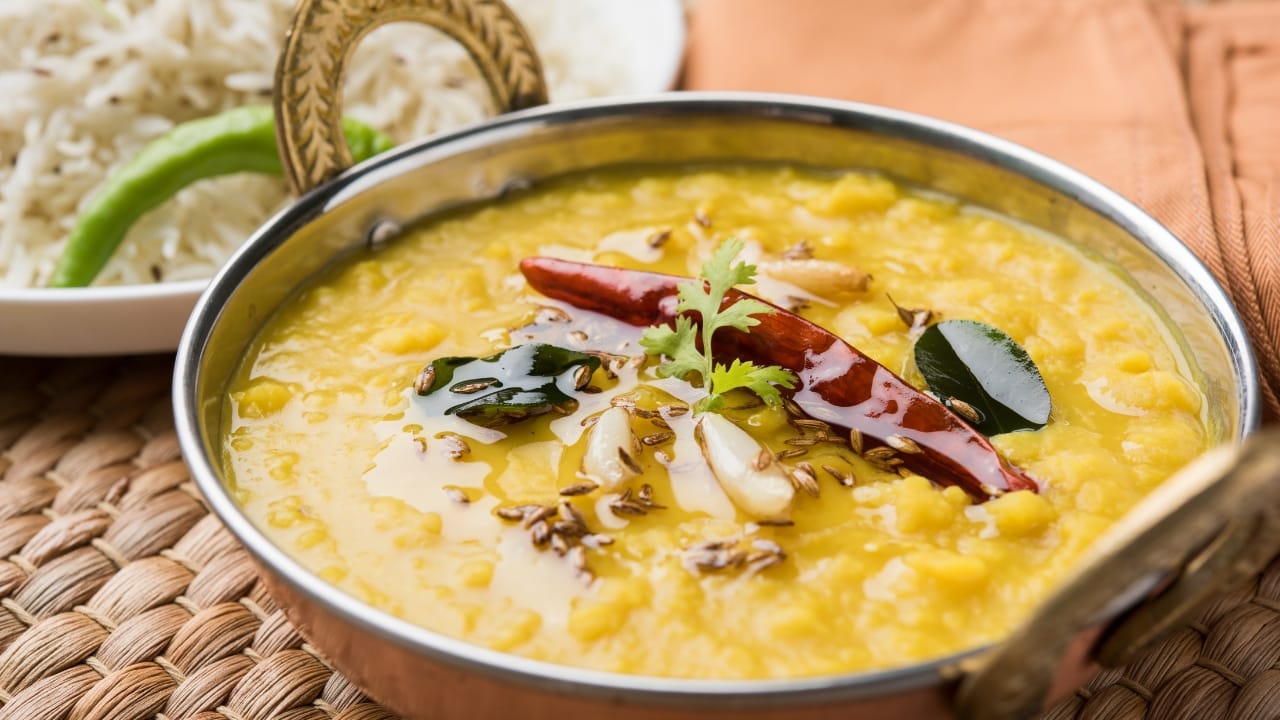
4) Ethiopia: Yellow Split Peas Curry (Kik Alicha)
Kik Alicha is a traditional Ethiopian dish made from yellow split peas. This mild and flavorful stew provides a subtle contrast to the typically spicier Ethiopian dishes, which are often seasoned with berbere. Known for its comforting, slightly sweet flavor and rich, creamy texture, Kik Alicha is a staple in Ethiopian cuisine. It's often enjoyed with injera, a traditional Ethiopian flatbread, and frequently served as part of a larger meal alongside other flavorful dishes.
Beloved in Ethiopian cuisine, Kik Alicha is often associated with the ancient Ethiopian Orthodox Christian fasting periods, during which adherents follow a plant-based diet. During these fasting times, legumes like split peas become staple ingredients, as they provide essential protein and nutrients. Its milder flavor profile also makes it more accessible to those who may find other, spicier Ethiopian dishes too intense.
Typical ingredients in Kik Alicha: Yellow split peas, onions, garlic, ginger, turmeric, vegetable oil or butter, salt, and water or vegetable broth. Sometimes, tomatoes and green chilies are added if a bit of heat is desired, though Kik Alicha is traditionally much milder than most Ethiopian dishes.
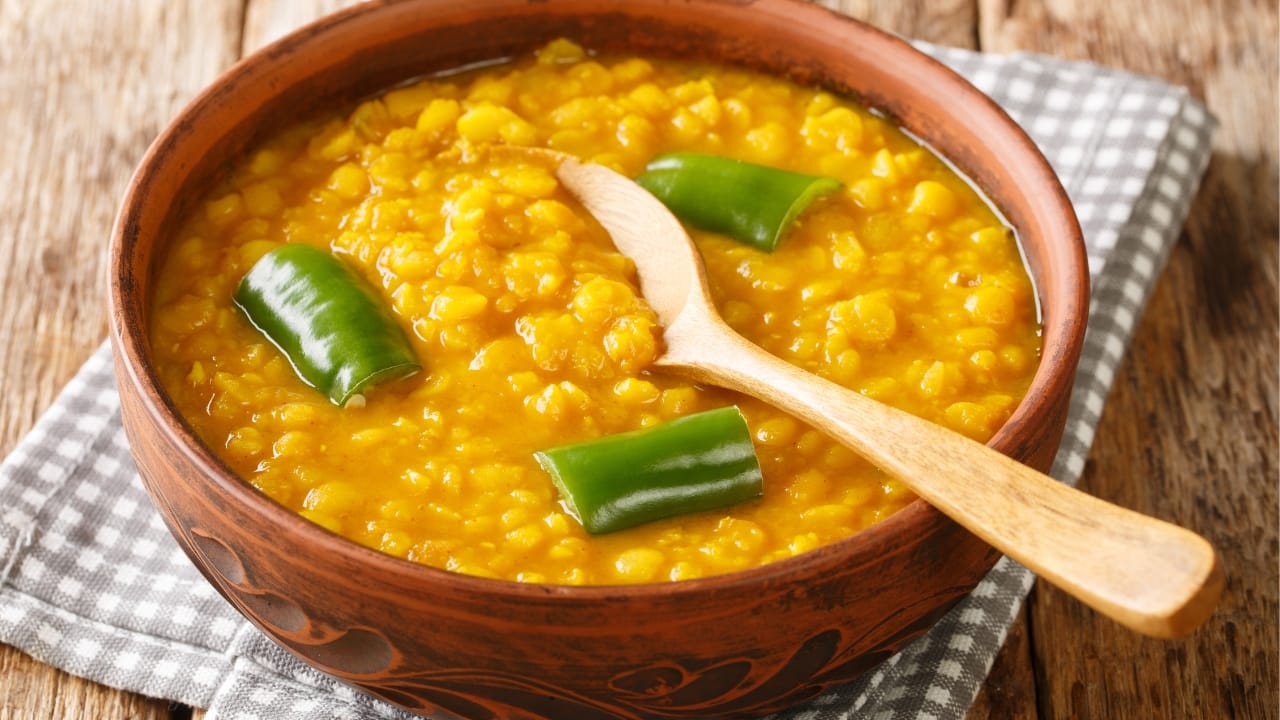
5) United States: Green Split Pea Soup
All the recipes above feature yellow split peas, but I had to include this green split pea version because it’s the type of American split pea soup I grew up with. I hadn’t actually tasted yellow split peas until I moved to Greece. One of my fondest memories is from the road trips my family and I would take up to Maine to visit my grandmother and aunt. Every time, we'd stop at a restaurant right at the state line, where my parents eagerly anticipated the traditional American green split pea soup—they would practically salivate during the last 100 miles! The soup was thick, savory, and creamy, with chunks of ham floating in it. It was the perfect satisfying meal for hungry travelers, and for me, it’s a cherished childhood memory wrapped up in taste and nostalgia.
Of course, a lot has changed over the years, and the classic American green split pea soup has inspired a variety of delicious adaptations across the country which now also use yellow split peas. Vegetarian Split Pea Soup has become popular among health-conscious eaters, featuring a hearty mix of vegetables like carrots, celery, potatoes and EVOO. Curried Split Pea Soup adds a flavorful twist, while Creamy Split Pea Soup is often finished with a splash of cream or coconut milk. Smoky Split Pea Soup incorporates smoked paprika or liquid smoke for extra depth, and Spicy Split Pea Soup brings the heat with jalapeños or red pepper flakes.
These variations not only reflect the modern and diverse culinary landscape of the United States, but they also cater to the wide range of tastes and dietary preferences in today’s melting pot, ensuring that split pea soup—whether green or yellow—remains a beloved staple across the nation.
Typical ingredients in Classic American Green Split Pea Soup: Green split peas, ham or a ham bone, onions, carrots, celery, garlic, bay leaves, thyme, vegetable or chicken broth, salt and pepper.
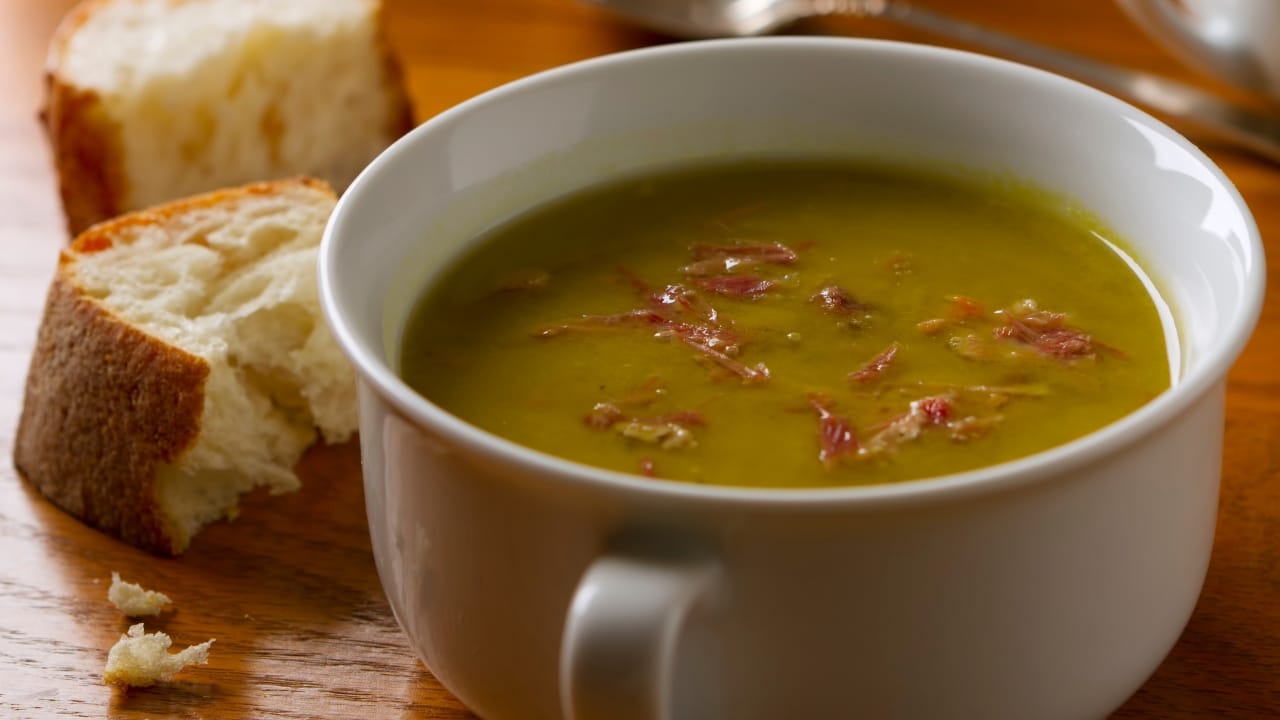
6) Greek/Mediterranean Yellow Split Pea Soup with High-Phenolic Olive Oil
Discover the recipe for this timeless dish below, steeped in both ancient and modern Greek tradition.
Please see our sister site, pjkabos.com (under "The Fat Olive) for the recipe's video and also read about the difference between garden peas, field peas, and split peas and the great synergy between yellow split peas and high-phenolic olive oil.
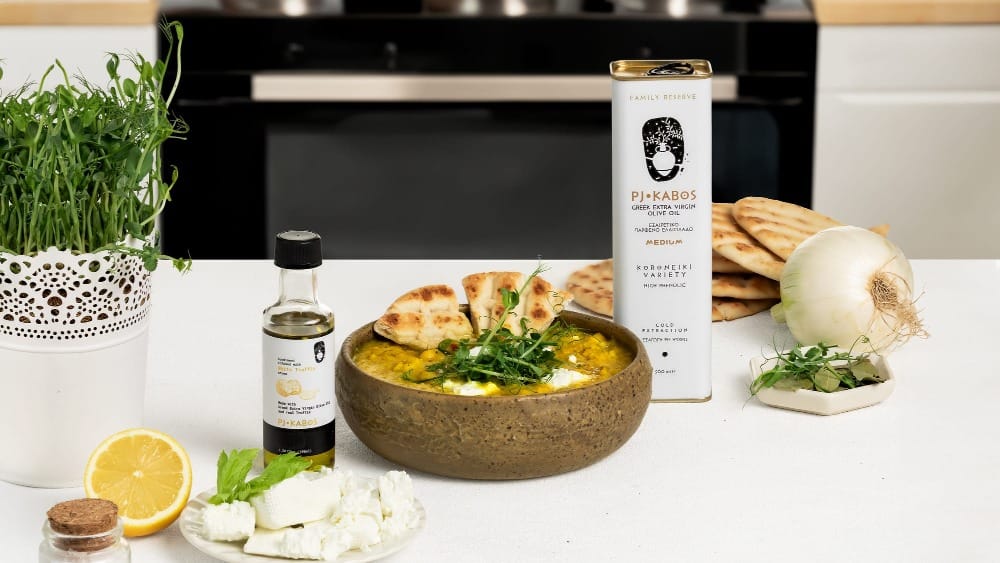
Part 2: Visual Recipe: Greek/Mediterranean Yellow Split Pea Soup with High-Phenolic Olive Oil
Legume—Soup; Serves: 6
PJ KABOS High Phenolic Extra Virgin Olive Oil to use:
- For cooking: Family Reserve Medium (White Tin)
- For finishing: Family Reserve Organic Robust (Black Bottle) or PJ Kabos Extra Virgin Olive Oil Black or White Truffle Oil
Ingredients
- 1 lbs package (500 g) yellow split peas, dried
- 2 large onions, diced
- 3 tablespoons PJ Kabos Extra Virgin Olive Oil, for sautéing the onion
- 2 celery stalks, chopped
- 1 teaspoon salt
- ¼ teaspoon pepper
- 1 cup PJ Kabos Extra virgin Olive Oil, for the end (when the split peas are no longer boiling)
- boiling water, as needed
For Serving:
- 1 lemon
- 6 to 8 teaspoons of High-Phenolic PJ Kabos Extra Virgin Olive Oil Family Reserve Organic Robust, for drizzling during serving or 4 teaspoon PJ Kabos White or Black Extra Virgin Olive Oil Truffle Oil (optional), for drizzling during serving
- celery, fresh leaves
- Fresh village bread, pita bread or Tiropita Koulouriou.
- pepper, sprinkling (optional)
- feta cheese, 3 to 4 bite-sized chunks, in each soup bowls
Preparation
Sift through the peas: Pour the dried split peas onto a plate and sift through them to ensure there are no stones or other foreign objects hidden among them (depending on the brand this is not always necessary).
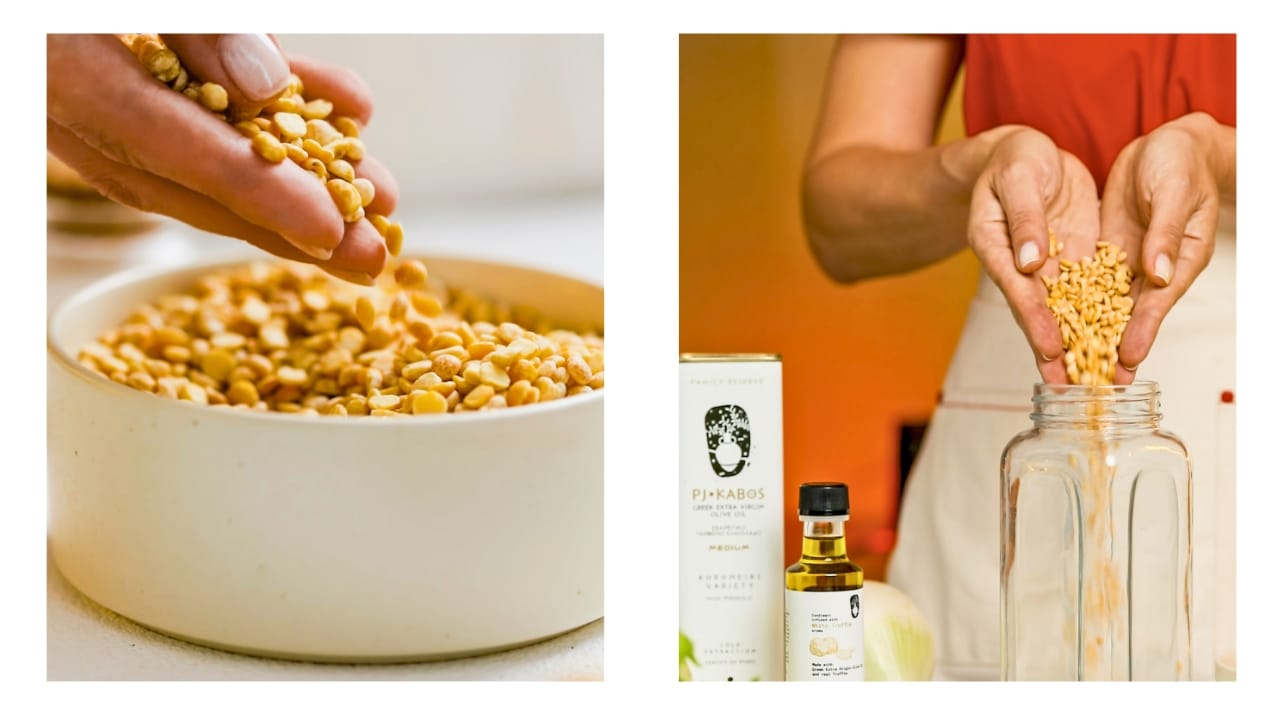
Soak the peas: Pour the cleaned split peas into a pot, run cold water over them and drain several times. Add cold water to cover the peas by three inches, lightly cover the pot (leave a small opening so the peas can breathe) and let the peas soak. We like to soak them for about 4 hours. After 4 hours, if you don’t wish to cook them at this time, place them in the refrigerator and cook within 24 hours of starting the soaking process. Change the water 2 or 3 times depending on how long they are soaked. (Again, some brands might not even need soaking).
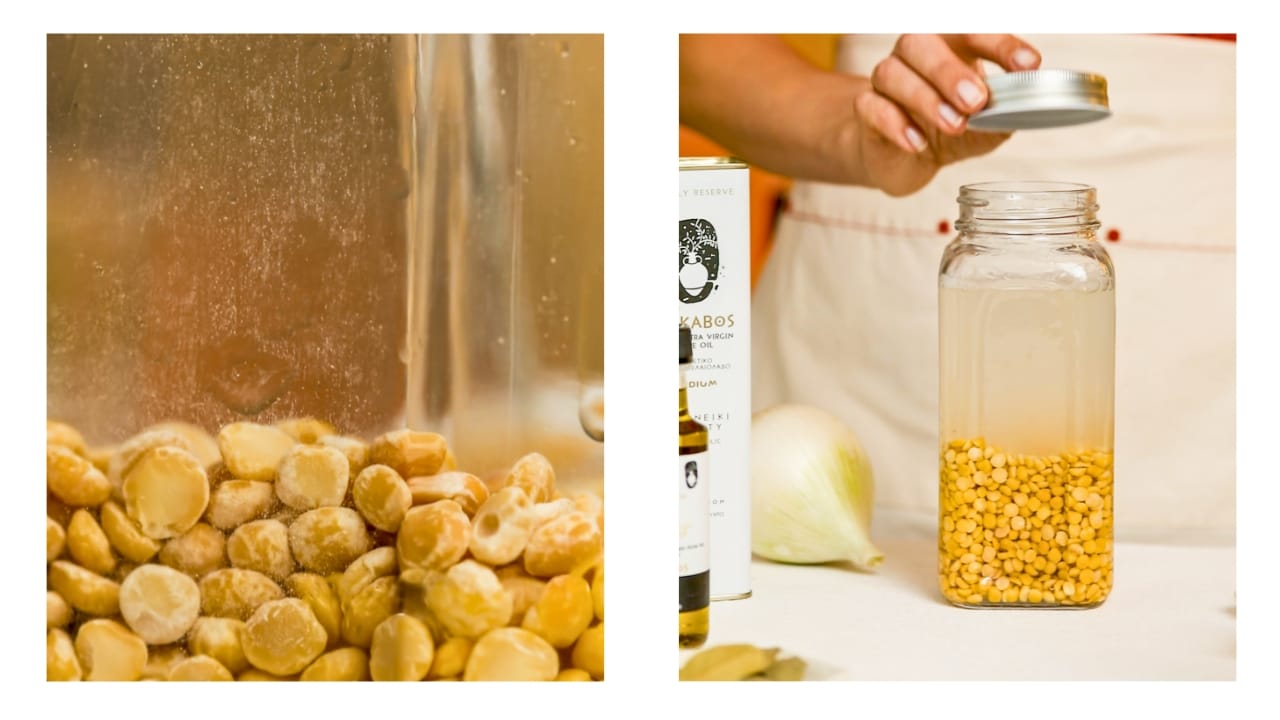
Onions: Sauté the onions until golden, then set aside. Note: Sautéing with high-phenolic extra virgin olive oil is not only safe but also enhances the health benefits of your dish.
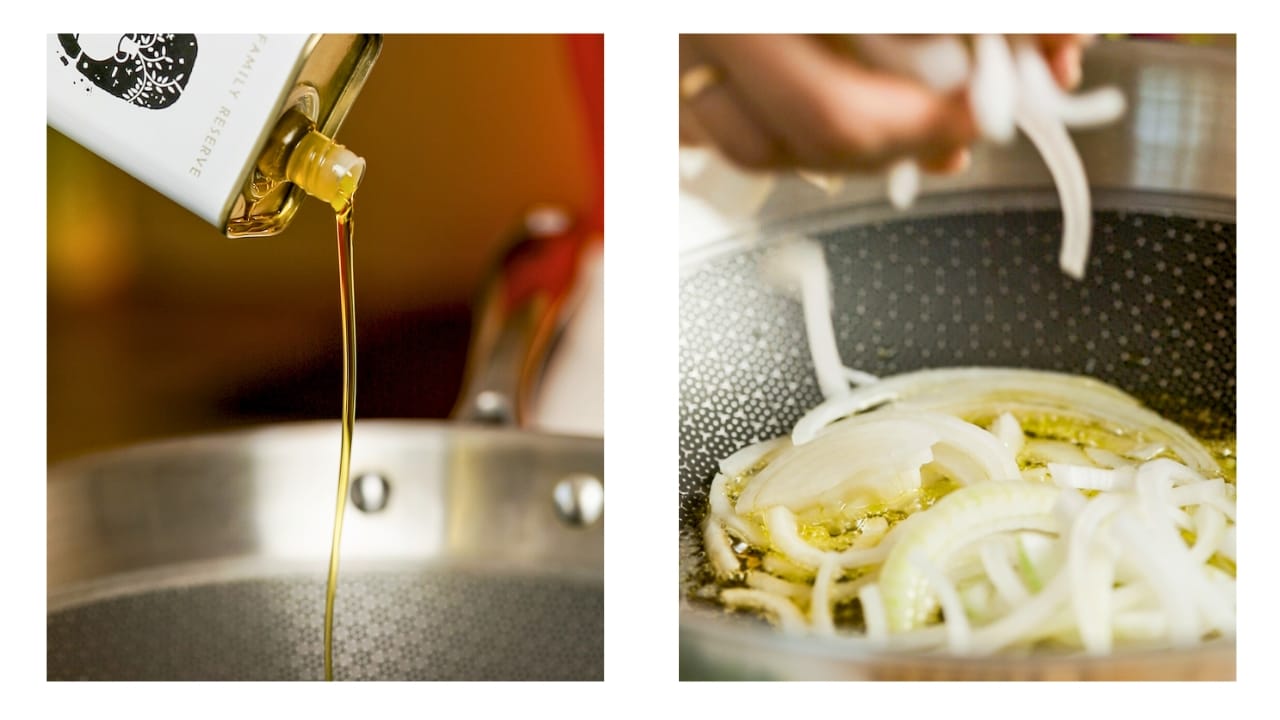
Cooking the peas: After soaking, empty the soaking water and fill the pot with fresh cold water.
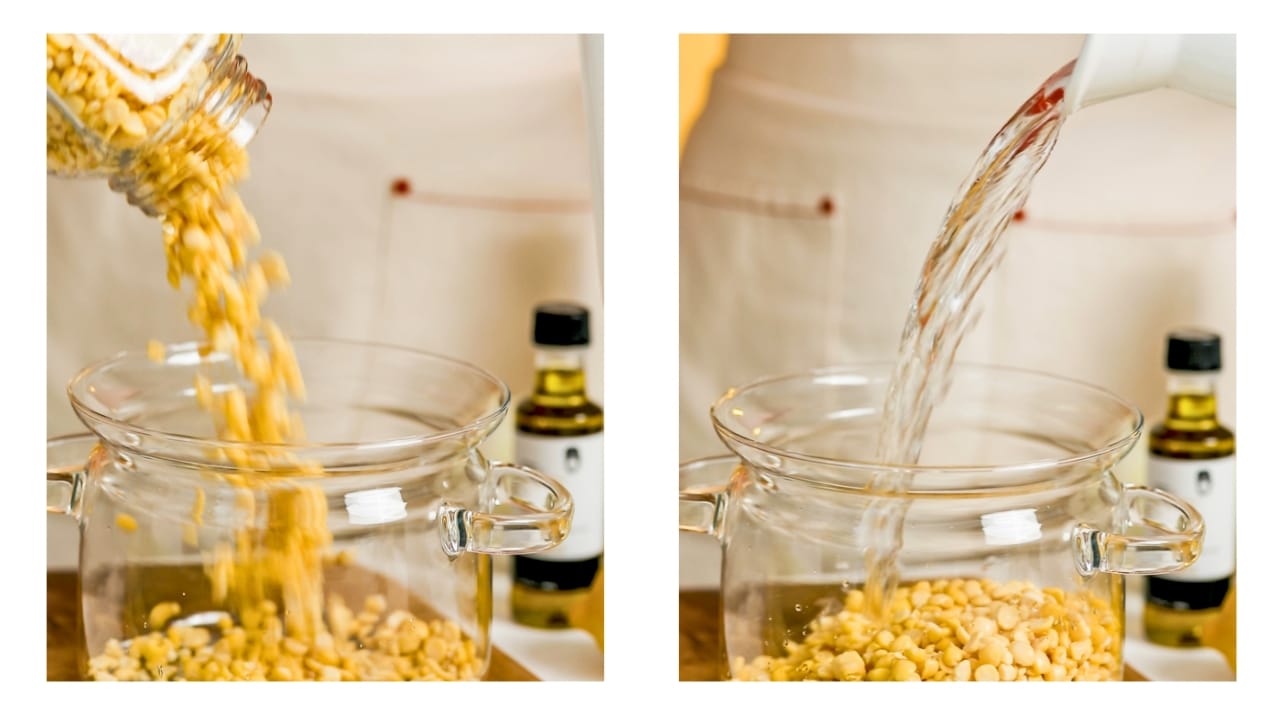
Place the pot on the stove and turn on medium. Be on hand to remove any foam that might form just before boiling. When the split peas start to boil add the sautéed onions along with its oil. This will help to prevent the peas from overflowing the pot (another tablespoon of oil may be added if needed). Turn the fire down one notch.
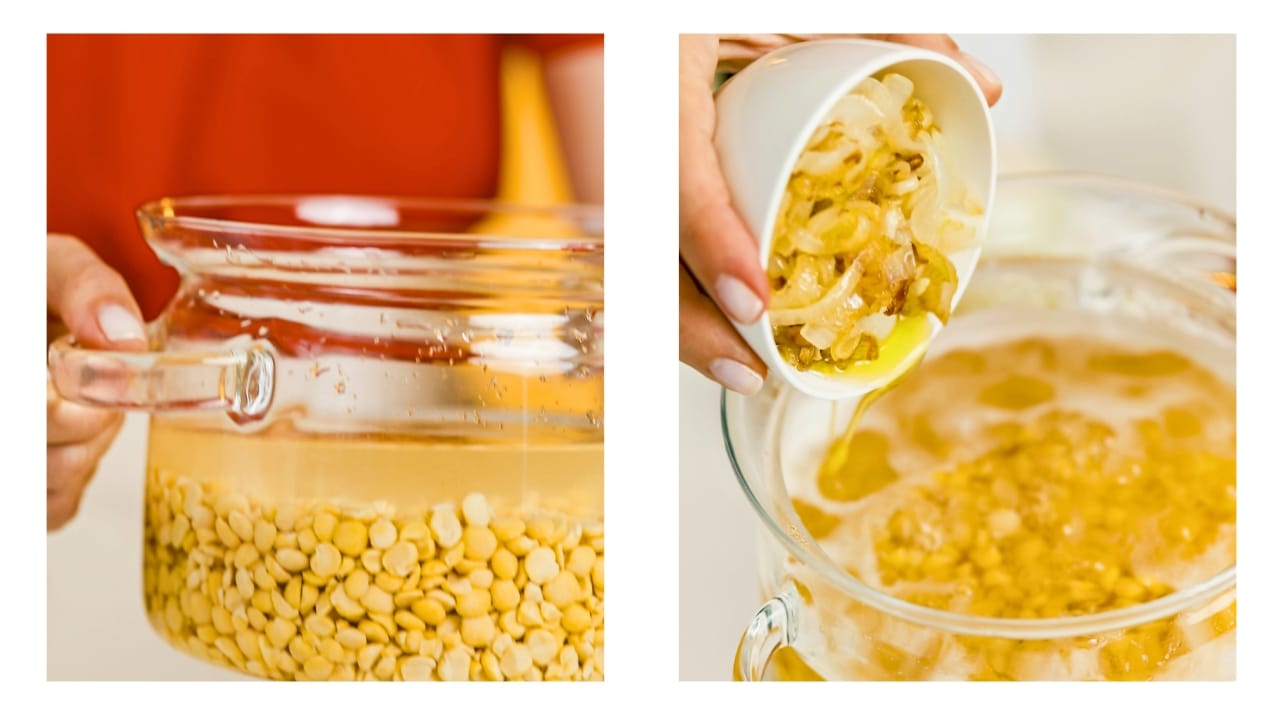
Add the celery and pepper. Boil on medium-high for 1 hour, or until the peas are tender, adding the necessary amount of boiling water, to bring the level in the pot back up to the starting point, however often needed. When the split peas are tender and have turned into a cream (normally about 1 hour) turn the temperature down to low, and continue to cook until you have the desired soup consistency. Add salt, stir, cover and turn off the split peas.
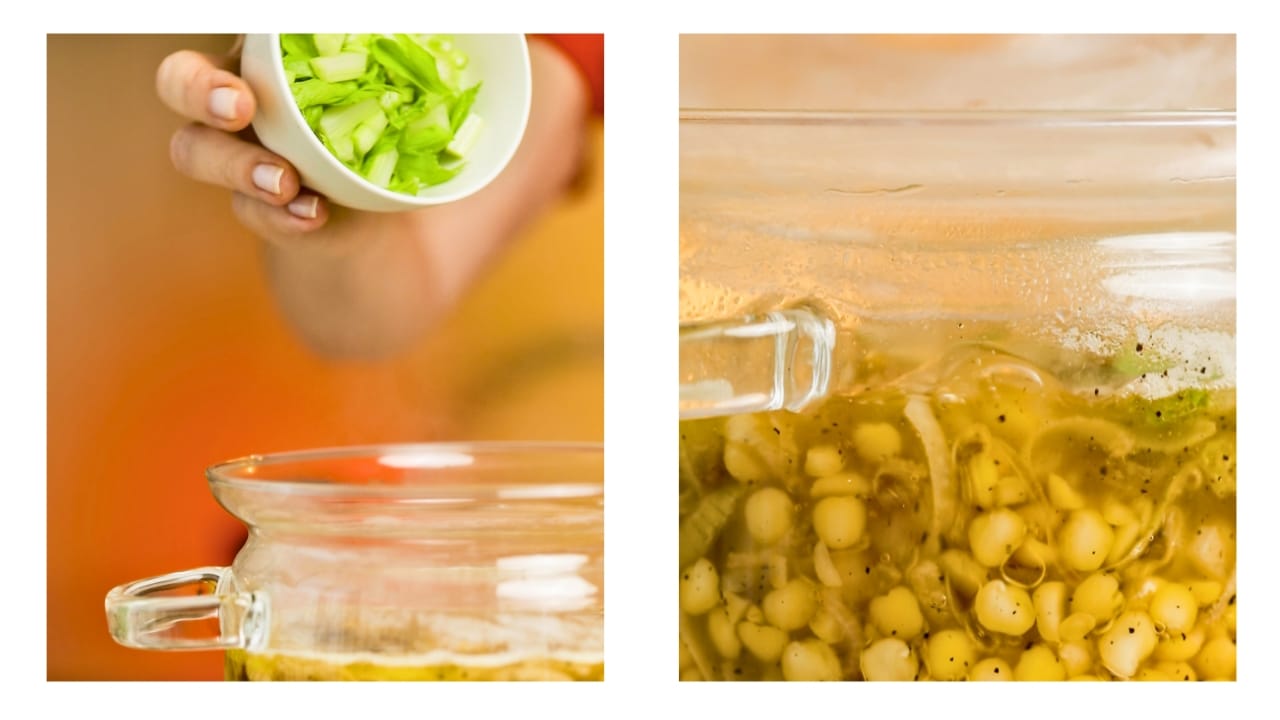
When they have stopped boiling and cooled a bit, add 1 cup PJ Kabos Extra Virgin Olive Oil. Gently stir in until well mixed.
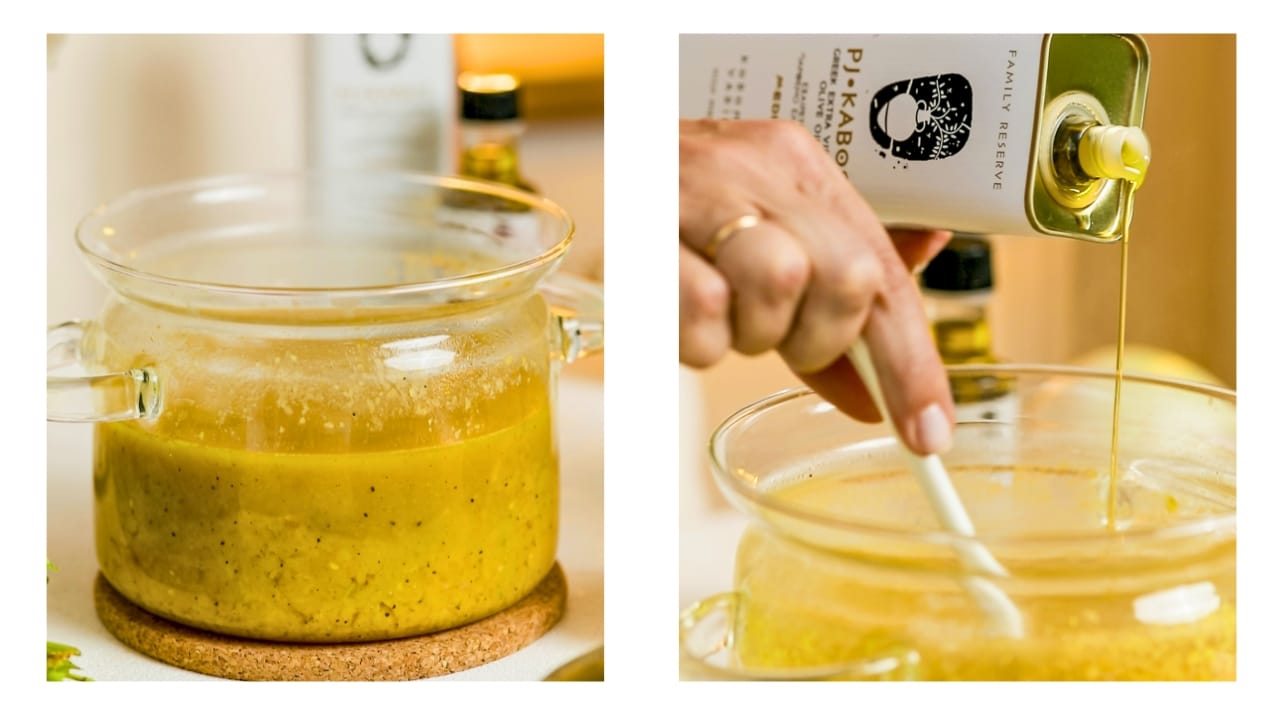
For Serving:
Into each serving bowl crumble feta cheese over the soup, add a squeeze of lemon juice, pepper, and a drizzle of PJ Kabos High-Phenolic Extra Virgin Olive Oil over the top or, for added flavor (a great deal of flavor!), a light drizzle of PJ Kabos Extra Virgin Truffle Oil (black or white).
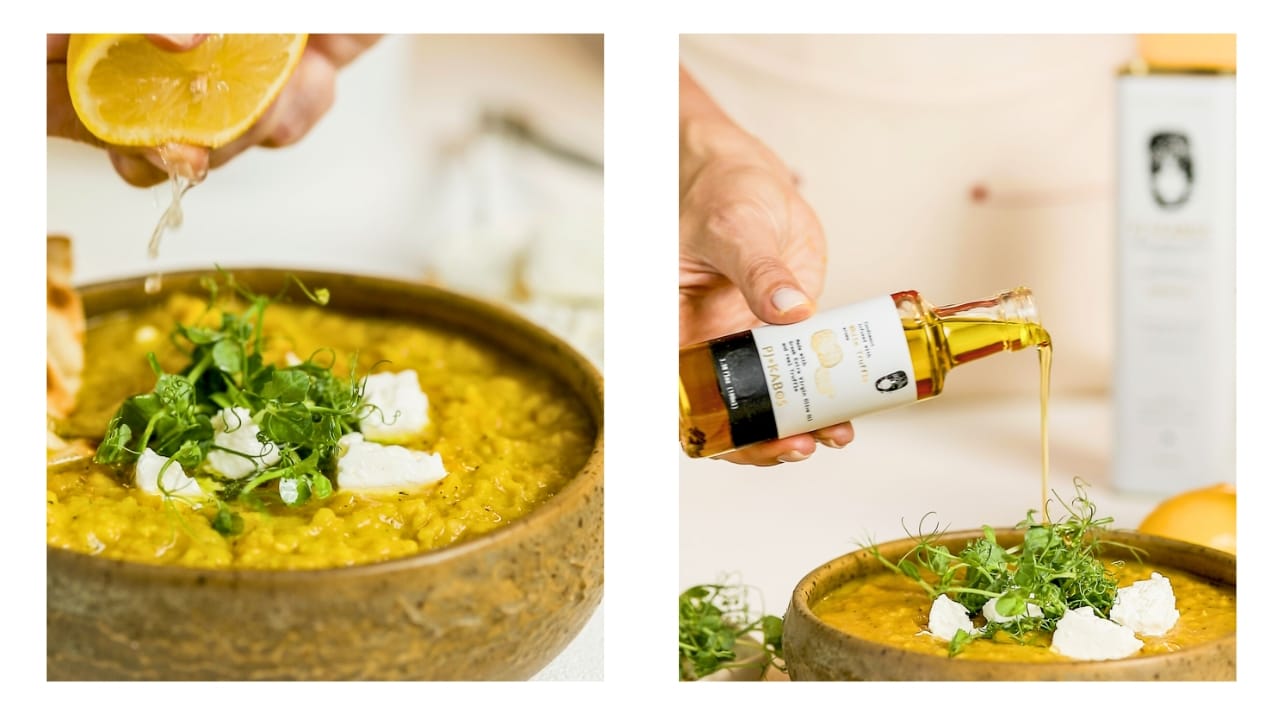
If desired add fresh celery.
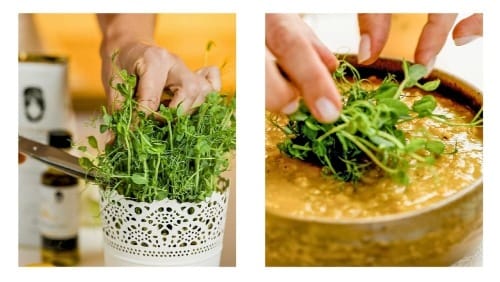
Serve with fresh village bread or pita bread, and for a real treat, enjoy with Tiropita Koulouriou, whether freshly prepared now or previously made.

Kali Orexi—Happy Eating!
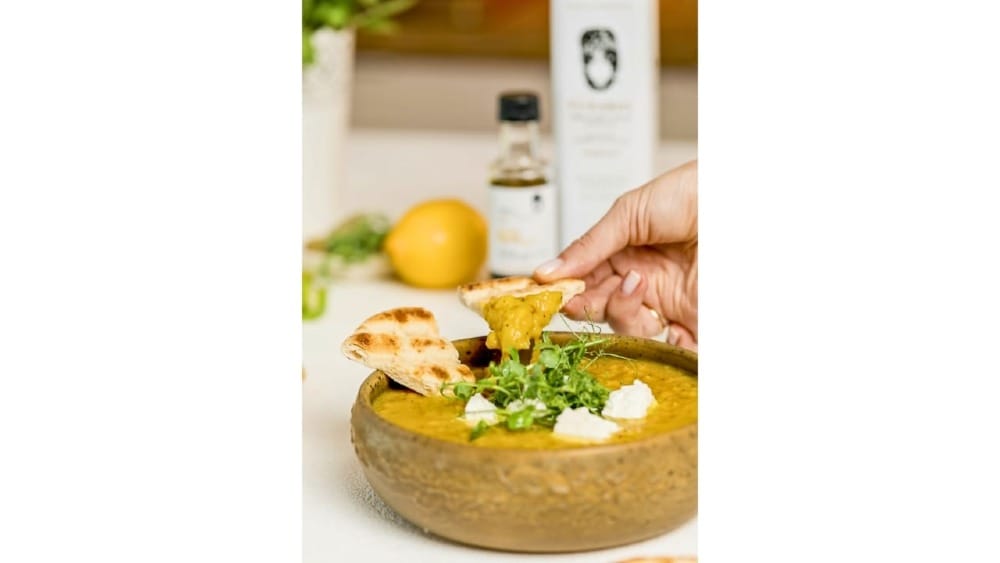
Fresh Harvest 2024/25
High-Phenolic Extra Virgin Olive Oil
from PJ KABOS
PJ Kabos Family Reserve Organic—Phenolic Shot
(Gold Bottle)
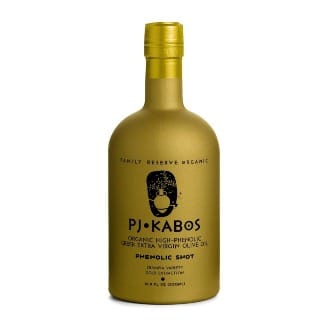
PJ Kabos Family Reserve Organic—"Phenolic Shot," is an award-winning extra virgin olive oil with possibly the highest phenolic content available in a true extra virgin olive oil today. Its intense bitterness and pungency clearly reflect the activity of these polyphenols. Meant to be taken as a shot or may be drizzled over salads, roasted vegetables, toast, fava, etc. to amplify both flavor and health benefits.
PJ Kabos Family Reserve Organic—Robust
(Black Bottle)
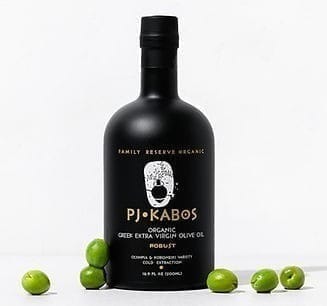
PJ KABOS Family Reserve Organic - Robust, is an extra virgin olive oil that is very high in polyphenols and adds depth, character and great health benefits to every meal.
PJ Kabos Family Reserve Organic—Medium Taste
(White Bottle)
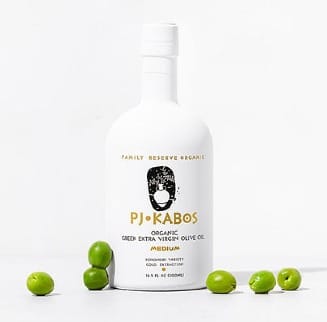
PJ KABOS Family Reserve Organic - Medium, is an extra virgin olive oil that is high in polyphenols and adds a lovely taste and great health benefits to every meal.
PJ Kabos Family Reserve—Medium Taste
(White Tin)
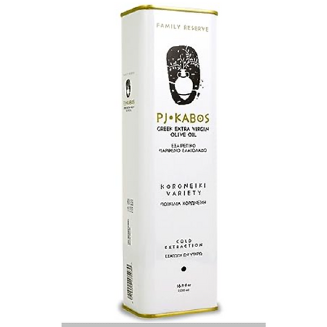
PJ KABOS Family Reserve - Medium, is an extra virgin olive oil in an easy-to-store tin that is high in polyphenols and adds a lovely taste and great health benefits to every meal.
Please enjoy having a look around our websites, pjkabos.com and oliveoil.com, as well as our Amazon Store for more about our many high-phenolic olive oils, recipes, history, etc. And follow along with us on Instagram for photos concerning olive oil production, our groves in Greece, articles about olive oil, family history and more.
PJ Kabos High-Phenolic Extra Virgin Olive Oil: Your Trusted Oil, Straight from Our Table to Yours.




